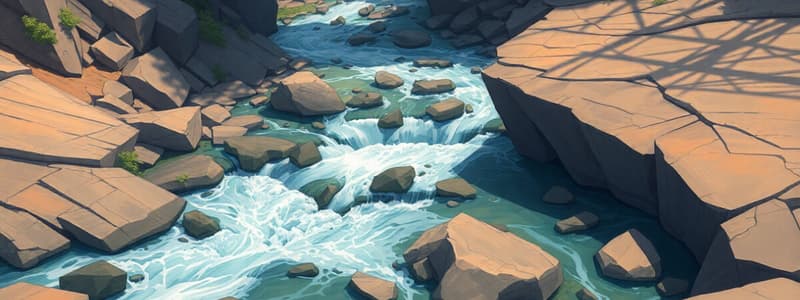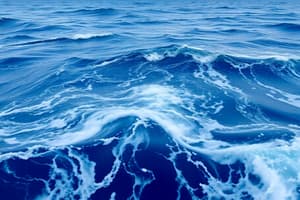Podcast
Questions and Answers
What characterizes a superimposed stream?
What characterizes a superimposed stream?
- It has the same stream pattern as the previous covering strata.
- It flows over bedrock of similar lithology to the overlying strata.
- It reflects the geology of the buried bedrock below.
- It is let down from overlying strata onto different lithology bedrock. (correct)
Which statement about stream order classification is true?
Which statement about stream order classification is true?
- The gradient of tributaries decreases downstream. (correct)
- The length of tributaries decreases downstream.
- The number of tributaries increases downstream.
- The size of the valley is unrelated to the size of the stream.
What determines the drainage pattern of a consequent stream?
What determines the drainage pattern of a consequent stream?
- The type of rocks it flows over.
- The age of the stream compared to the surrounding landscape.
- The direction of the slope of the land. (correct)
- The depth and width of the stream channel.
How does stream discharge change as one moves downstream?
How does stream discharge change as one moves downstream?
Which type of stream maintains its course across raised crust due to younger geological activity?
Which type of stream maintains its course across raised crust due to younger geological activity?
What is the shape of the longitudinal profile of a typical stream?
What is the shape of the longitudinal profile of a typical stream?
Which factor does NOT influence the flow of water in natural streams?
Which factor does NOT influence the flow of water in natural streams?
Which type of stream is typically found on weak rock or geologic structures?
Which type of stream is typically found on weak rock or geologic structures?
What primary feature distinguishes braided streams from meandering streams?
What primary feature distinguishes braided streams from meandering streams?
Which type of stream is primarily associated with high-gradient areas and large sediment loads?
Which type of stream is primarily associated with high-gradient areas and large sediment loads?
In which area would you expect to find alluvial fans formed by sudden drops in stream velocity?
In which area would you expect to find alluvial fans formed by sudden drops in stream velocity?
What feature is typically found on the outside of meander bends where erosion occurs?
What feature is typically found on the outside of meander bends where erosion occurs?
What type of sediment transport dominates in braided streams?
What type of sediment transport dominates in braided streams?
How is sinuosity defined in the context of stream types?
How is sinuosity defined in the context of stream types?
Which characteristic is typical for floodplains?
Which characteristic is typical for floodplains?
Which type of stream is noted for having a large suspended load and a subordinate coarse bed load?
Which type of stream is noted for having a large suspended load and a subordinate coarse bed load?
What is the main difference between permanent and intermittent streams?
What is the main difference between permanent and intermittent streams?
How does the shape of a stream channel influence its velocity of flow?
How does the shape of a stream channel influence its velocity of flow?
What does the term 'base level' refer to in the context of stream profiles?
What does the term 'base level' refer to in the context of stream profiles?
What primarily determines the competency of a stream regarding sediment transport?
What primarily determines the competency of a stream regarding sediment transport?
What are the different modes of sediment transport in streams?
What are the different modes of sediment transport in streams?
What effect does the building of a dam have on local stream dynamics?
What effect does the building of a dam have on local stream dynamics?
How does stream velocity relate to the stream gradient?
How does stream velocity relate to the stream gradient?
Which statement is true regarding the maximum flow in a channel?
Which statement is true regarding the maximum flow in a channel?
Flashcards are hidden until you start studying
Study Notes
Superimposed Streams
- Superimposed streams occur when water flows down from overlying strata onto buried bedrock with a different composition or structure.
- The stream pattern is dictated by the geology of the previous overlying strata, not the current underlying rocks.
Stream Orders & Properties
- As stream order increases, the following changes occur:
- Fewer tributaries downstream
- Longer tributaries downstream
- Reduced gradient downstream
- Wider and deeper channels downstream
- Valley size proportional to stream size
Stream Drainage Patterns
- Consequent Streams: Determined by the slope of the land. Typically found on massive or gently sloping rocks, often with dendritic patterns.
- Subsequent Streams: Flow through bands of weaker rock or geologic structures.
- Antecedent Streams: Maintain their course across areas uplifted by younger folding or faulting.
Flow of Water in Streams
- Influenced by:
- Stream gradient
- Stream discharge
- Stream velocity
- Channel shape
- Base level
Stream Gradient
- Steep at the source, tapering to gentle slopes at the mouth.
- Exhibit a concave-upward longitudinal profile.
Stream Discharge
- Volume of water flowing past a point in a given time (measured in m³/sec).
- Tends to increase downstream in tropical and temperate climates.
- Turbulent flow occurs where velocity changes abruptly, especially near the channel bottom, keeping sediment in suspension.
Laminar vs. Turbulent Flow
- Laminar Flow: Smooth, parallel streamlines, low velocity.
- Turbulent Flow: Irregular, chaotic flow, high velocity.
Sediment Transport and Bedforms
- The flow of water over sediment creates geometric features called bedforms, like ripples and dunes.
Alluvial Fans
- Cone-shaped deposits of coarse-grained alluvial sediment.
- Form along mountain fronts where high-gradient streams enter lowlands.
- Sudden drop in velocity causes rapid sedimentation.
- Dominated by gravel and sand.
Braided vs. Meandering Streams
- Braided Streams:
- Interwoven converging and diverging channels.
- Separated by tear-shaped bars of sand and gravel.
- Dominated by bedload transport due to high flow velocities.
- Common in piedmont areas with steep gradients and heavy sediment loads, also found in glacial and desert regions.
- Meandering Streams:
- Relatively high sinuosity (ratio of channel length to straight-line distance).
- Large suspended load, with subordinate coarse bedload.
- Thalweg (line of maximum depth) is close to the outer bank, causing erosion at cut banks.
- Curved sand bars or mud banks accumulate on the inner side of bends (point bars).
- Meander loops may become close enough for the river to cut across, forming abandoned meanders (oxbow lakes).
Floodplains
- Wide, flat plains bordering streams, periodically inundated by flood waters.
- Gravel and sand are mainly deposited within the channel (channel deposits).
Stream Velocity
- Fastest flow where there is least friction, generally above the deepest part.
- The line of maximum depth and strongest currents is the thalweg.
- In bends, maximum velocity shifts to the outside of the bend, while minimum velocity occurs on the inside.
- Stream velocity is proportional to stream gradient.
- Stream's capacity to transport sediment increases greatly with velocity.
Channel Shape
- Stream cross-sectional area increases with increasing discharge.
- Channel shape influences flow velocity.
- A semi-circular channel offers the least surface area per unit volume, minimizing friction and maximizing velocity.
- Wide, shallow channels have higher friction, slowing flow.
Base Level
- The lowest level to which a stream can erode its channel.
- The sea is the ultimate base level.
- Lakes, dams, and stream junctions act as local base levels.
Stream Load
- Amount of material transported by a stream at a given time.
- Generally less than its capacity.
- Capacity: Maximum quantity of sediment a stream can carry past a point. Proportional to the discharge of the stream.
- Competence: Maximum sediment size a stream can carry, determined by flow velocity.
Types of Sediment Load
- Bed Load: Sediment rolling or sliding along the streambed.
- Suspended Load: Sediment carried in suspension by the water.
- Dissolved Load: Dissolved minerals transported by the water.
Sediment Transport
- Mode of transport depends on the settling velocity of the particle.
Studying That Suits You
Use AI to generate personalized quizzes and flashcards to suit your learning preferences.





